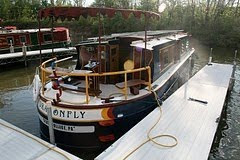On Wednesday we cruised to an area called Sans Souci--and to a harbor on
Fryingpan Island.
We’d been advised to watch out for floatplanes coming and going at the dock. And sure enough, a small white plane circled and landed on the water as we were approaching.
We’d been advised to watch out for floatplanes coming and going at the dock. And sure enough, a small white plane circled and landed on the water as we were approaching.
This is the home of “Henry’s Fish Restaurant and Aerodrome.”
It’s been in existence for decades and we understand it’s a “must-stop”
destination if you are boating in the area.
There really was a Henry, a local fisherman, as I understand
it, who opened a small restaurant to sell some of his catch. The place has grown . . . Henry retired . . .and he sold the
business to a genial guy in a safari shirt named Paul (who answers to Henry,
because that’s what people expect).
Anyway, Henry’s is now “World Famous” thanks to an article
in the foodie magazine Saveur singing its praises.
As for the float planes, Georgian Bay Airlines has a package deal for
tourists out of Parry Sound, ten miles away: Scenic air tour of Georgian Bay, lunch at Henry’s included
in the price. You sit at long
tables, family style, next to pretty much every other boater who is passing within a 20-mile
radius. (Helpful hint: take your charts with you to dinner and you'll meet lots of interesting people!)
 |
| Not too far to walk to dinner! |
Some places we go, we worry whether the docks will be long enough, or whether the
water at the docks will be deep enough for our boat (which is considered large
at 41 feet!)—but not here. The shoreline on Frying Pan Island falls off
precipitously; about three feet from shore the water is 20 feet deep.
As we approached the dock, I followed my usual routine: walk
along the little outside walkway (which is about 10 inches wide) up to the bow, and grab
the heavy, green nylon mooring line, ready to jump to the dock.
We got used to handling our own lines on the Erie Canal, where the
lock tenders won’t touch them, and where--at the public docks where we spent the
nights—there are no attendants.
We’d assumed this was the norm, so we were surprised, on the
Trent-Severn, when in some of the busier locks, like Bobcaygeon and Fenelon
Falls, we saw the lock tenders taking the ropes for some boaters. Weren’t we supposed to do it ourselves?
Turns out these locks
are close to businesses that rent houseboats . . . and houseboat skippers with no previous experience are said to receive a good few minutes of
training before they go out on the water. So lock tenders on the Trent are used to helping out.
But we quickly
learned that the Trent Severn lock tenders were NOT too used to vessels of our weight. The first time a lock tender signaled, “Pass me your line,” I
thought, “Oh wow, how civilized! I don’t have to leap four feet out and two feet down from the moving boat, across
the water, onto the lock wall. I don't have to worry about whether I'll land upright, or whether I'll be able to run fast enough to loop the rope
around a bollard and retard our motion before our boat smashes into the wall or the boat in
front of us. This is a lock tender. She knows how to handle boats.
So I handed off the line, and the lock tender took it . . . and she stood there. And the boat still
had plenty of forward way . . . and it was gliding, gliding, gliding . . . and she was standing there . . . and it was evident she had no idea how much mass was on the other end of the line, or that she was about to get yanked into the canal while
our boat smashed into the wall.
So I yelled for her to step back and jumped out and grabbed
the line and looped it around the bollard, and all was well.
But the experience made us kind of protective of our lines.
Approaching Henry’s, we could see the wharf crew—college
kids in bright red shirts and khaki shorts--hustling to handle the lines on a
small runabout.
We’d been directed to “Dock C”--very long, the perfect
height, no other boats to maneuver between. An easy approach for our skipper, an easy jump for me. Yay.
We didn’t know the local etiquette, apparently. As we
approached, the dockhands, who'd been helping another boat, glanced up, saw us, looked distressed, and came literally sprinting over to take the lines and tie us up securely--spring lines and all. They seemed politely perplexed by the idea of self-service boaters,
kind of the way staff in a really good hotel are perplexed when you handle your
own suitcases.
 |
| While dockhands hustle, boaters relax |
When we went in to dinner (deep-fried pickerel, it’s
mandatory) we noticed the rustic dining room has historic photos on the walls---and
some that are a bit more recent.
And we realized why it is these dockhands are so good with big
boats. One of the photos shows a Henry’s deckhand, hands on hips,
smiling, in front of a 100-foot-long cruise ship, tied up securely at the dock.






No comments:
Post a Comment